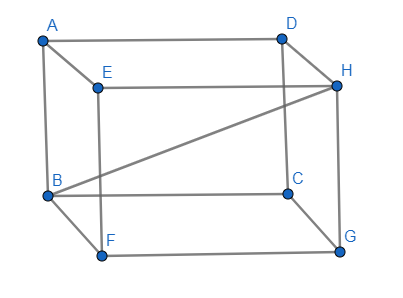
The length of the longest pole that can be put in a room of dimensions 10m×10m×5m is:
(a)15m
(b)16m
(c)10m
(d)12m
Answer
420.7k+ views
Hint: We have to find the length of a longest pole means the longest distance in a room. As it is given that room is in the form of cuboid so the longest length of a line in the cuboid is a diagonal of the cuboid.
Complete step-by-step answer:
The dimensions of a room given in the question are in the form of a cuboid i.e. (10m×10m×5m).
Now, in the question it is asked that we have to fit the longest pole in the cuboid. It means we need to find the space in a cuboid which can accommodate the longest pole.
In a cuboid, the longest length is the diagonal of a cuboid. So, if we know the diagonal of a cuboid we can fit the longest pole there.

In the above figure, BH is the diagonal of a cuboid.
A cuboid having length = l, breadth = b, height = h then the formula of the diagonal of a cuboid is:
$\sqrt{{{l}^{2}}+{{b}^{2}}+{{h}^{2}}}$
And the dimensions of a room are given as 10m×10m×5m where l = 10m, b = 10m and c = 5m then substituting the values of l, b and h in the above expression we get,
$\begin{align}
& \sqrt{{{\left( 10 \right)}^{2}}+{{\left( 10 \right)}^{2}}+{{\left( 5 \right)}^{2}}} \\
& =\sqrt{100+100+25} \\
& =\sqrt{225} \\
& =15 \\
\end{align}$
From the above calculations, the length of the diagonal is 15m.
Hence, the longest pole which can be put in a room is 15m.
Hence, the correct option is (a).
Note: Don’t forget to write the units of length. And the derivation for the length of the diagonal is given below:
Imagine you are sitting in a room then “l” is the length of the floor and “b” is the breadth of the floor then the length of the diagonal of a floor is$\sqrt{{{l}^{2}}+{{b}^{2}}}$. Now, you can imagine a right angled triangle whose base is the diagonal of a floor and height is the height of the room “h” and hypotenuse is the diagonal of a room so applying Pythagoras theorem on this right angled triangle.
Hence, diagonal of a room is $\sqrt{{{l}^{2}}+{{b}^{2}}+{{h}^{2}}}$
Complete step-by-step answer:
The dimensions of a room given in the question are in the form of a cuboid i.e. (10m×10m×5m).
Now, in the question it is asked that we have to fit the longest pole in the cuboid. It means we need to find the space in a cuboid which can accommodate the longest pole.
In a cuboid, the longest length is the diagonal of a cuboid. So, if we know the diagonal of a cuboid we can fit the longest pole there.

In the above figure, BH is the diagonal of a cuboid.
A cuboid having length = l, breadth = b, height = h then the formula of the diagonal of a cuboid is:
$\sqrt{{{l}^{2}}+{{b}^{2}}+{{h}^{2}}}$
And the dimensions of a room are given as 10m×10m×5m where l = 10m, b = 10m and c = 5m then substituting the values of l, b and h in the above expression we get,
$\begin{align}
& \sqrt{{{\left( 10 \right)}^{2}}+{{\left( 10 \right)}^{2}}+{{\left( 5 \right)}^{2}}} \\
& =\sqrt{100+100+25} \\
& =\sqrt{225} \\
& =15 \\
\end{align}$
From the above calculations, the length of the diagonal is 15m.
Hence, the longest pole which can be put in a room is 15m.
Hence, the correct option is (a).
Note: Don’t forget to write the units of length. And the derivation for the length of the diagonal is given below:
Imagine you are sitting in a room then “l” is the length of the floor and “b” is the breadth of the floor then the length of the diagonal of a floor is$\sqrt{{{l}^{2}}+{{b}^{2}}}$. Now, you can imagine a right angled triangle whose base is the diagonal of a floor and height is the height of the room “h” and hypotenuse is the diagonal of a room so applying Pythagoras theorem on this right angled triangle.
Hence, diagonal of a room is $\sqrt{{{l}^{2}}+{{b}^{2}}+{{h}^{2}}}$
Recently Updated Pages
You are awaiting your class 10th results Meanwhile class 7 english CBSE

What is meant by livestock class 10 biology ICSE

A person is eligible to be a member of Lok Sabha but class 10 social science CBSE

Explain Five Year Plans of India

Who laid the foundation for the Portuguese in India class 10 social studies CBSE

What are the modes of nutrition Explain in detail various class 10 biology CBSE

Trending doubts
Full Form of IASDMIPSIFSIRSPOLICE class 7 social science CBSE

Fill in the blanks with appropriate modals a Drivers class 7 english CBSE

What are the controls affecting the climate of Ind class 7 social science CBSE

The southernmost point of the Indian mainland is known class 7 social studies CBSE

What were the major teachings of Baba Guru Nanak class 7 social science CBSE

What was the approximate time period of the Indus Valley class 7 social science CBSE




